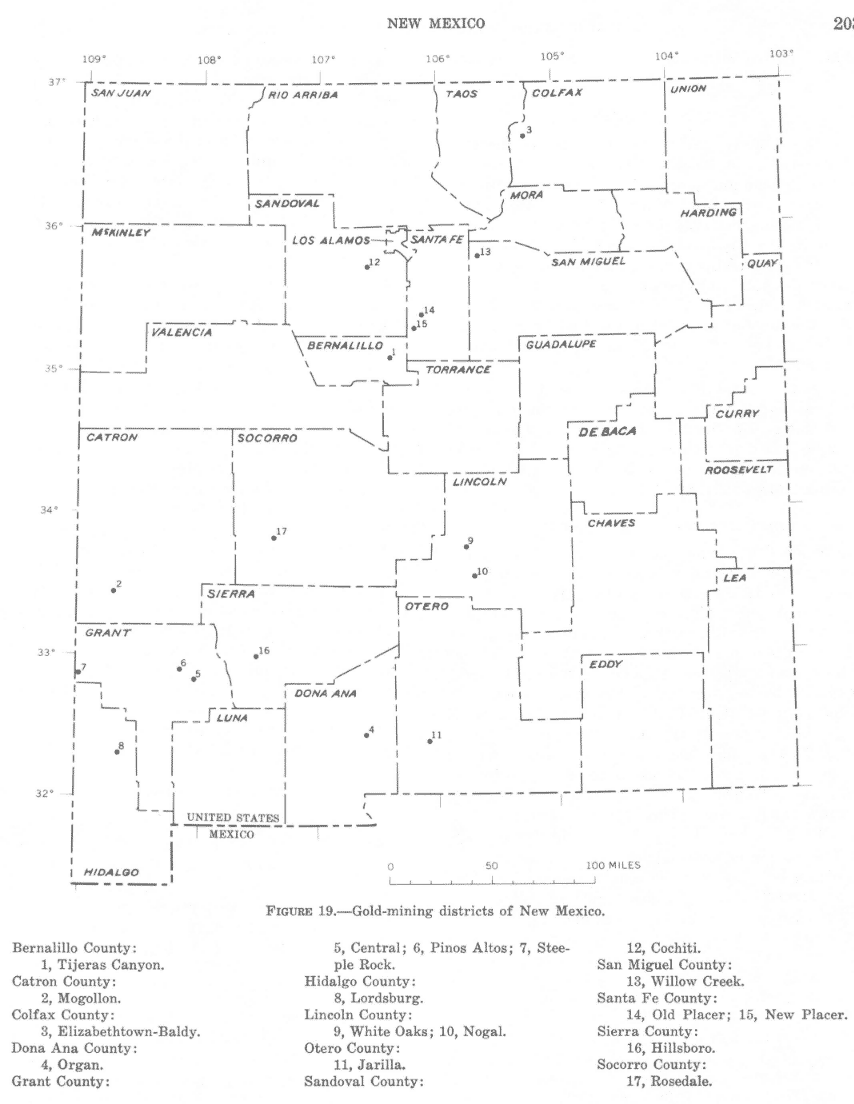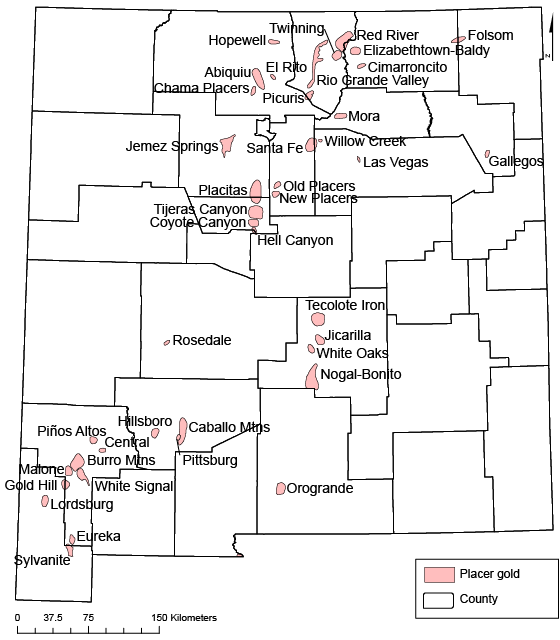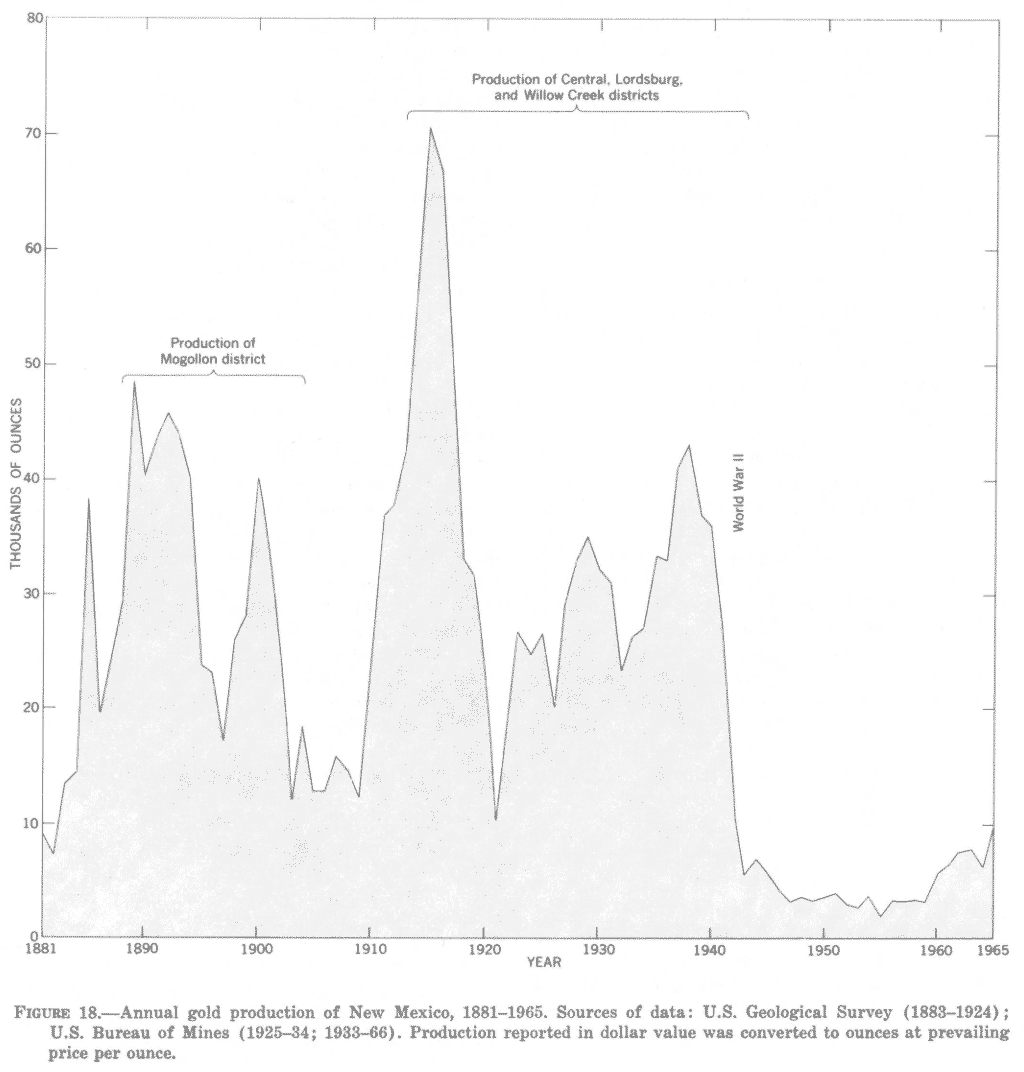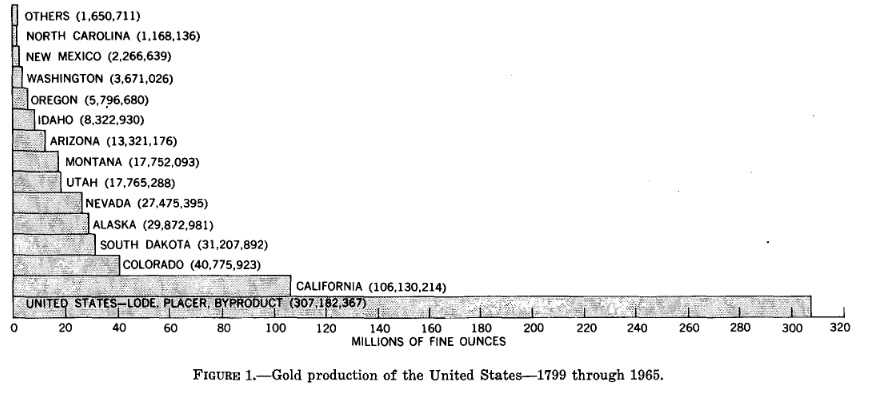
New Mexico is known for placer gold deposits. Read in the article about the history of gold mining in the New Mexico, about its only major gold producing mine and other facts and figures about gold mining in NM.
Contents
- Is there Gold in New Mexico?
- Where is Gold in New Mexico?
- What is the History of Gold Mining in New Mexico?
- How much Gold has been Mined in New Mexico?
- What is the Current State of Gold Mining in New Mexico?
- How Many Gold Reserves are in New Mexico?
- What Companies Mine Gold in New Mexico?
- Where are New Gold Mines Explored or Developed in New Mexico?
- Is it Legal to Mine Gold in New Mexico?
- Where Can I Pan for Gold in New Mexico?
- Is There Gold in Other US States?
Is there Gold in New Mexico?
Yes. However, gold production nowadays is limited to only one major mining operation.
Facts about gold mining in New Mexico:
- New Mexico is one of the 11 states that contribute towards the US gold production
- Placer mining along the Rio Grande in the 1600s.
- Gold production only as a byproduct at the biggest copper mine of the state, the Chino mine, owned by Freeport-McMoRan Inc.
- Gold mining mostly recreational these days.
- The US Geological Survey lists 1316 sites in New Mexico with gold deposits. These are mostly historical mines such as: Black Hawk Mine, Copper Flat, Groundhog Mine, Hanover Mountain Mine and the Alabama Mine
Key Takeaways:
| Fact | Explanation |
|---|---|
| Remember | Significant Gold produced by one copper mine as a byproduct |
| Gold Deposits | Yes |
| Discovery Year | 1600s placer gold mining in the Rio Grande; in 1828 discovery in the Ortiz Mountains that led to a gold rush |
| Discoverer | Not recorded |
| Gold Mining Industry | Still active |
| Major Gold Locations | Placer deposits, see 3rd map |
| Major Active Gold Mines | one mining operation left: the Chino Copper mine, produces gold as a byproduct |
| Mining Companies | Freeport-McMoRan Inc. |
| Panning Locations | Many historical gold panning locations allow recreational panning |
The following map of New Mexico shows the location of the first substantial gold discovery that led to a gold rush and the only major mine that produces substantial amounts of gold (as byproduct from copper mining).

Check out the video about gold prospecting in Sierra County, New Mexico:
Where is Gold in New Mexico?
Gold in New Mexico can be found in several locations, particularly in the northern and central parts of the state. Some key areas include:
- Ortiz Mountains in Santa Fe County: The site of one of the earliest gold rushes in the western United States, with significant placer gold deposits discovered in 1828.
- Elizabethtown–Mount Baldy area near Eagle Nest: Known for an important gold strike in the late 1800s.
- Pinos Altos and Silver City: Regions where gold mining occurred, along with other minerals.
- Mogollón area: Another historic mining location with gold discoveries.
- Jémez Mountains and Caballo Mountains: Regions with smaller gold deposits.
These areas predominantly contained placer gold deposits, formed from the concentration of gold in river and stream sediments. However, most of these deposits were small and were quickly exhausted. Today, while large-scale commercial gold mining is not prevalent in New Mexico, these areas still hold interest for recreational gold panning and prospecting.
The next map shows gold mining locations in New Mexico in the 1960s.

Sources: USGS
What is the History of Gold Mining in New Mexico?
New Mexico has a rich history of gold mining. Francisco Vasquez de Coronado, a Spanish explorer searching for gold, traveled the region that eventually became New Mexico in 1540–1542.
Who Discovered Gold in New Mexico?
The origins of gold mining in New Mexico are not attributed to a single individual but to early mining activities dating back to the 1600s. Placer mining, a method of extracting gold from river sediments, was reported along the northern Rio Grande during this period.
However, the significant discovery that sparked the first gold rush in the western United States occurred in 1828 in the Ortiz Mountains, “Old Placers” district in Santa Fe County.

When was the Gold Rush in New Mexico?
New Mexico experienced its first significant gold rush in the 1820s, predating the famous California gold rush of 1849. This was the first gold rush west of the Mississippi. This early gold rush centered around the Ortiz Mountains, north of Albuquerque. It attracted thousands of men from around the world, seeking their fortune in the newly discovered gold fields. The rush led to the establishment of numerous mining camps and the proliferation of gold mining activities across the state.
All mining activity was suspended from 1861-62 when during the Confederate invasion.
When did the Gold Mining Industry Start in New Mexico?
In the late 19th century, gold mining in New Mexico experienced a significant surge, notably beginning with a major discovery in the Elizabethtown–Mount Baldy area, close to Eagle Nest. Additional strikes were made in regions like Pinos Altos, Silver City, Mogollón, as well as in the Jémez and Caballo Mountains. Despite these numerous finds, the majority of the gold deposits were relatively small and were quickly depleted.
By 1900, most of the known placer gold deposits in New Mexico had been discovered, and mining had become a significant part of the state’s economy (see the map below of placer gold in the state). The more productive ore zones typically occurred as narrow “pay streaks” or layers of fine-grained, disseminated gold, often found in alluvial gravel deposits.

Gold production peak occurred in the 1890s from the production in the Mogollon district and in the 1910s from the production of the Central, Lordsburg and Willow Creek districts (see chart).

When did the Gold Mining Industry Decline in New Mexico?
The decline of the gold mining industry in New Mexico began in the early 20th century. The focus shifted from gold and silver mining to base-metal mining, particularly copper. This transition was marked by the commencement of large-scale copper mining in the Central district in Grant County in 1912. Most of the state’s gold output since then has been a byproduct of copper and other base-metal ores. The decline in gold mining was also influenced by the exhaustion of many of the smaller gold deposits and the shift in the state’s mining industry toward other minerals like oil, gas, copper, and potash.
Sources: Mining Artifacts, New Mexico Bureau of Geology and Mineral Resources, USGS
How much Gold has been Mined in New Mexico?
More than 3,2 million oz of have been produced in New Mexico from 1848 through 2000. And 0,662 million oz gold from placer deposits from 1828 till 1991; see chart.
The U.S. Geological Survey reports the following production numbers in kilogram:
- 304 (2006)
- 400 (2007)
- 218 (2008)
- 14 (2009)
For other years, there are no publicly disclosed production numbers.
In 1965 New Mexico was number 12 in the ranking gold ever produced by US states, which was 2,266,639 ounces. The ranking was led by California, Colorado and South Dakota (see below).

Sources: National Mining Association, New Mexico Bureau of Geology and Mineral Resources, USGS
What is the Current State of Gold Mining in New Mexico?
At the beginning of the 21th century, active gold mining operations in New Mexico came to a halt. Although the state continued to produce gold as of today, this production is solely as a byproduct of copper mining activities, rather than from mines exclusively dedicated to gold extraction. Gold in significant amounts is only produced at the Chino copper mine in Grant county.
The current state of gold mining in New Mexico is characterized primarily by recreational and hobbyist activities, rather than large-scale commercial mining.
What are major gold mines in New Mexico?
The US Geological Survey Minerals Yearbook lists in its most recent overview 44 gold operations in the US of which only one gold producing operation is located in the state of New Mexico: the Chino mine, owned by Freeport-McMoRan Inc.
The US state leading the ranking is Nevada with 27 operations, followed by Alaska with four operations, California and Arizona have each 3 mines listed.
Overview of the gold operation in New Mexico:
| US Rank | Operation | County and State | Majority Owner (2024) | Qty 2020 |
Qty 2021 |
|---|---|---|---|---|---|
| – | Chino | Grant, NM | Freeport-McMoRan Inc. | – | – |
Explanation:
Rank: a comparison of the output of US mines. Eight of the ten biggest mines are in Nevada and one in Alaska. No ranking given for Chino, as quantity is not disclosed.
Quantity: now quantity shown in the Minerals Yearbook to avoid disclosing proprietary data.
What is the major active gold mine in New Mexico?
Chino, the open pit copper mine, is the biggest copper mine in New Mexico. It is located in Grant county, 15 miles east of Silver City. It produces as byproducts molybdenum, gold and silver. Owner is Freeport-McMoRan since 2007. The pit is 1.75 miles across and 1,3500 feet deep. Originally mined by native Indians and later by Spaniards, Open-pit mining began in 1910. The expected mine life is 2047.

Sources: miningdataonline, New Mexico Bureau of Geology & Natural Resources, USGS
How Many Gold Reserves are in New Mexico?
There is no estimation about gold reserves in New Mexico.
Source: New Mexico Bureau of Geology & Natural Resources
What Companies Mine Gold in New Mexico?
Freeport-McMoRan Inc. owns the only large mine in New Mexico that produces gold (as a byproduct). This is the Chino Mine; see satellite image.
Some facts about Freeport:
- Headquarter in Phoenix, Arizona
- Founded in 1912
- 24,700 employees
- Producer of copper (one of the largest producers worldwide), gold, molybdenum (world-largest producer)
- Mining operations: in the US in Arizona (5 operations), New Mexico (2 operations), Colorado (2 operations), South America (Chile and Peru, each 1 operation), Europe (Spain, 1 operation) and in Indonesia, 49% owner of the famous Grasberg mine, which is the world’s 3rd biggest gold mine and 2nd biggest copper mine (by reserves).

Source: company website
Where are New Gold Mines Explored or Developed in New Mexico?
There are no new gold mines currently being explored or developed in New Mexico.
However, there is a copper mining project in New Mexico, which could produce gold and other resources (molybdenum and silver) as byproducts. This is the Copper Flat Mining Project:
- Location: Sierra County, New Mexico, 20 miles southwest of Truth or Consequences
- Type: open-pit copper mining
- Developer: New Mexico Copper Corporation, a subsidiary of THEMAC Resources Group Limited
- Status: Permitting
- Mineral Reserves and Resources: Measured, Indicated, and Inferred reserves are estimated at 305,226 tons with an average grade of 0.23% copper, 0.007% molybdenum, 0.078% gold, and 1.55 g/t silver
- Production: The project plans to produce 10.2 million short tons per year, with a mill head grade of 0.298% copper and a mill head grade of 0.378% copper equivalent
Sources: krge, New Mexico Tech, THEMAC
Is it Legal to Mine Gold in New Mexico?
The regulations for gold mining in New Mexico are governed by the General Mining Laws of 1872, as amended, and the 36 CFR 228 rules and regulations for mining activities on National Forest System (NFS) lands. Prospecting for gold, including hobby and recreational purposes, is subject to these laws. Here are some key points regarding the regulations for gold mining in New Mexico:
Permits and Authorizations:
-
- Gold panners (excluding dredging) and rock collectors causing little or no surface disturbance with hand tools only, under 2 cubic yards per year, do not require a permit from the state of New Mexico. However, some types of activities may require prior notice or authorization.
- A Dry General Permit must be obtained from the state of New Mexico’s Mining and Minerals Division for activities causing between 2 and 5 acres of surface disturbance per year.
- A Wet General Permit is required for activities causing between 1 and 2 acres of surface disturbance per year.
- Restrictions:
-
- All dredging operations are limited to a 2-inch diameter hose, and high banking or sluicing is not allowed.
- Claim Records:
-
- The New Mexico State Office of the Bureau of Land Management maintains mining claim records, and it is important to check with local authorities before prospecting to avoid legal issues.
- Public and Private Locations:
-
- There are public and private locations where gold panning is allowed, and it is essential to be aware of the specific regulations and requirements for each location.
It is important for individuals engaged in gold prospecting and mining activities to familiarize themselves with the applicable laws and regulations, obtain any necessary permits or authorizations, and adhere to the restrictions to ensure compliance with the legal framework governing mining activities in New Mexico.
Sources: Forest Service, State Bureau of Mines and Natural Resources
Where Can I Pan for Gold in New Mexico?
Check out the video about where to find gold in New Mexico:
New Mexico offers several locations where you can pan for gold.
See also the information package about gold panning in New Mexico, created by the New Mexico Bureau of Geology and Mineral Resources.
Here are some of the best spots:
- Pinos Altos: Located in Grant County, north of Silver City, it’s known for its historical gold lodes and offers serene gold prospecting opportunities in areas like Bear Creek.
- Rio Grande River: The gravels and floodplain of the Rio Grande are known to contain gold, especially near the Taos Mountains. This river, along with its tributaries like the Rio Hondo and Red Rivers, offers good prospects for gold panning.
- Willow Creek: A well-known location for gold panning in New Mexico, with a rich mining history since the 1800s. It remains an active area for gold prospecting, especially near the old mining town of Pinos Altos.
- Jicarilla Mountains: These mountains are rich in both native history and gold. Streams like Rio Nutrias and Willow Creek within this area are known for gold placer deposits.
- San Pedro Mountains: Situated north of Santa Fe, these mountains were significant for gold mining in the late 1800s. The area around the town of Golden and the Ortiz Mine Grant are still promising for gold prospecting.
Each of these locations offers unique opportunities for gold panning, with a blend of historical significance and ongoing potential for finding gold. Remember to check local regulations and respect the environment when engaging in prospecting activities.
Sources: how to find rocks, bizarre hobby
Is There Gold in Other US States?
Check out gold production in neighboring states of New Mexico: Colorado, Oklahoma, Texas, Arizona and Utah.
According to the U.S. Geological Survey (USGC), there are 11 states that mine gold and contribute towards the gold mining statistic: Nevada is responsible for the majority of gold output, around 72%, followed by Alaska (13%). 9 other contribute in sum to the remaining 15% of gold production: Arizona, California, Colorado, Idaho, Michigan, New Mexico, South Carolina, South Dakota, and Utah.
